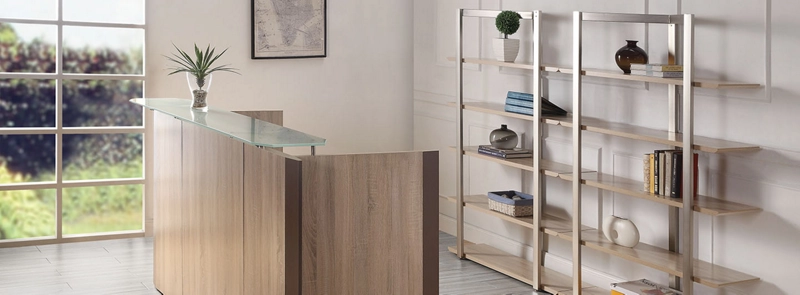The white-hot, post-pandemic labor market is putting more pressure on office design than ever. Space planning, which has long held influence driving employee and organizational outcomes, has been pushed to the forefront as a key driver for attracting new talent and enhancing employee retention.
Your organization’s reception area is your first impression—for potential hires who have come to interview and for employees walking in to start their workday, not to mention clients, partners, and other visitors.
How Reception Space Planning Has Changed
According to the recent Gensler US Workplace Survey, workers want a new mix of experiences in the office. Where a staid reception design in the past might have been good enough, workers are now demanding an office that creates experiences similar to a clubhouse, boutique hotel, and coffee shop.
According to Gensler, “Before the COVID-19 pandemic, the workplace was on a trajectory toward diversifying experience to match the dynamic nature of work. Now, these expectations have been amplified, and office workers want a more diverse mix of experiences—so much so that the majority (83%) report they would be more willing to return to the office more regularly if their ideal experiences were met.”
In the Gensler survey, younger workers demonstrated a clear preference for hospitality-infused experiences. Older workers also said they’d like to see a mix of hospitality-infused experiences with more traditional businesslike settings.
With some simple updates, you can give workers the experience they want, taking your reception space from an attrition liability into an attrition asset. And we’ll show you how.
What a Reception Area Needs to Do
To maximize the ROI of office updates, approach the project from this perspective: “What needs to be done in this space, and how can I help that happen?” The same way you would outline the job description for a role, we’re going to outline the job description for a reception space. Once you have that info, you’ll be able to make stronger choices that drive a bigger impact.
Jobs That Need to Be Done in the Space
-
Receiving: For most companies, this looks like including a reception desk where your receptionist can check in guests, receive packages, and act as the public face of the office.
-
Waiting: If a guest or potential hire visits your office, they will likely have to wait in the reception area for at least a few minutes. Your reception design needs to include somewhere they can do this comfortably.
-
Charging: Many people will benefit from the option of a charging station, either to top up their laptop before a presentation or a phone so that they have enough power to map their train ride home. Choosing furnishings outfitted with AC and USB power shows visitors and potential hires that you understand the demands of modern living and that you’re here to support them.
-
Learning about your organization: A visitor's downtime can be an added opportunity to learn about your space. Whether you like it or not, the time they spend in your reception area will determine how they feel about your organization, so embrace it. Include print materials on end tables about what sets you apart. Find a way to highlight your mission statement or something cool about your organization. Furnish the space in a style that evokes the brand message you want to convey.
What You Need Reception Furnishings to Provide
-
Comfort: Comfortable reception furniture cultivates patience and cultivates relaxation. Fill your reception area with furnishings that will have people saying, “I love it here already.”
-
Durability: Let’s face it—reception is a high-traffic area. You need furnishings that will stand up to regular wear and tear over time.
-
Accessibility: People are diverse, and your reception furnishings should be, too. Incorporate solutions that will make people with varying needs feel welcome.
Top Reception Area Trends for 2023 and Beyond
Reception spaces are shifting from waiting room to “living room.” You can achieve this effect by embracing hospitality. Think “amentity-rich boutique hotel.” One of the top trends for reception furniture is “resimercial’ furniture. Resimercial, which is a blending of the words residential and commercial, brings the warmth of home furnishings to commercial-grade furniture. This ensures that you can provide warmth while also choosing furniture that will withstand the test of time (especially important for high-traffic areas like reception).
The second biggest trend is tables and seating with built-in power. This provides guests with a convenient way to grab a charge while also keeping your reception area looking clean and polished. Whether you opt for powered furniture or not, you want to be sure that you have end tables and coffee tables so that visitors have a surface where they can place drinks, notebooks, laptops, bags, or other items.
Plants and greenery continue to trend. Spending time around plants has been shown to boost moods. And when your reception area is filled with greenery that requires regular care, it sends the message that the space is lived in and stewardship is part of your organizational culture. Just be sure to choose easy-to-maintain plants so that your receptionist doesn’t have to become an expert horticulturist overnight.


0 Comments